Dubbing is a powerful tool for making content accessible to a global audience, and Spanish, being one of the most widely spoken languages, is a prime target for this type of content localization. Whether you're creating marketing content for different regional Spanish accents (Castilian, Mexican, or neutral Latin American Spanish), translating a podcast, or localizing a popular show like major studios such as Deluxe Spain or SDI Media do, dubbing can significantly expand your reach across all 21 Spanish-speaking countries. In this guide, we will explore how to dub a video in Spanish using AI voices, covering everything from traditional dubbing methods to the latest artificial intelligence technologies.
What is Spanish Dubbing?
Spanish dubbing is the process of replacing the original audio in a video with a voice over in Spanish, carefully synchronized to match the lip movements, tone, and emotional delivery of the original speaker. Spanish dubbing does more than just translate words like subtitles—it captures cultural and linguistic nuances unique to the Spanish language.
For example, in some regions of Latin America, certain expressions like "platicar" (to chat) are more common, whereas in Spain, the equivalent "charlar" might be preferred. Beyond vocabulary, the Spanish dubbing process may also need to adjust for speech patterns, such as the rolled "r" sounds more prominent in certain Spanish-speaking countries, or the way sentences are structured with different colloquialisms to ensure the content feels natural and relevant to the target Spanish-speaking audience.
Spanish Dubbing Options: Traditional vs. AI Video Dubbing
As filmmakers and content creators alike seek to expand their reach to Spanish-speaking audiences, choosing the right voice dubbing method is crucial. There are two primary options: traditional Spanish dubbing with voice actors and AI-powered automated dubbing. Understanding the advantages of each method helps in selecting the best fit for your project so let’s dive in:
Spanish Traditional Dubbing
Traditional dubbing requires hiring professional voice actors who are fluent in the target language and understand the specific nuances of regional Spanish dialects. For example, a voice actor dubbing for a Mexican audience would use "ustedes" for "you all," while someone dubbing for a Spanish audience in Spain would use "vosotros." Additionally, regional expressions like "che" in Argentine Spanish or "guagua" for "bus" in Cuban Spanish reflect the cultural depth that professional actors can bring to a project. This method ensures authenticity and emotional expression, but it can be costly and time-consuming, as it requires finding actors who can accurately represent the desired dialect (e.g., Mexican Spanish vs. Castilian Spanish) and working closely with directors to capture the nuances of the performance.
AI-powered Spanish Dubbing
Automated dubbing powered by AI technology uses machine learning algorithms to generate realistic, natural-sounding voice overs. Spanish AI voice generators can analyze the original audio, translate it, and produce a dubbed version in Spanish, all while syncing the speech to the video’s lip movements. Unlike traditional dubbing, AI-powered dubbing automatically detects and applies the correct Spanish dialects based on the target audience.
For instance, AI can instantly switch between Castilian Spanish, where "ordenador" is used for "computer," and Latin American Spanish, where "computadora" is preferred. It also handles subtleties in pronunciation across dialects. This makes AI dubbing a fast, cost-effective, and highly adaptive solution for projects like marketing campaigns, social media videos, or eLearning courses, where quick turnaround and accuracy are essential.
How to Dub a Spanish Video Using AI Voices with Speechify Studio
Speechify Studio offers an intuitive platform to dub videos using Spanish AI voices. Here’s a step-by-step guide:
Start a new project: Select “start a new project” and then “dubbing.”
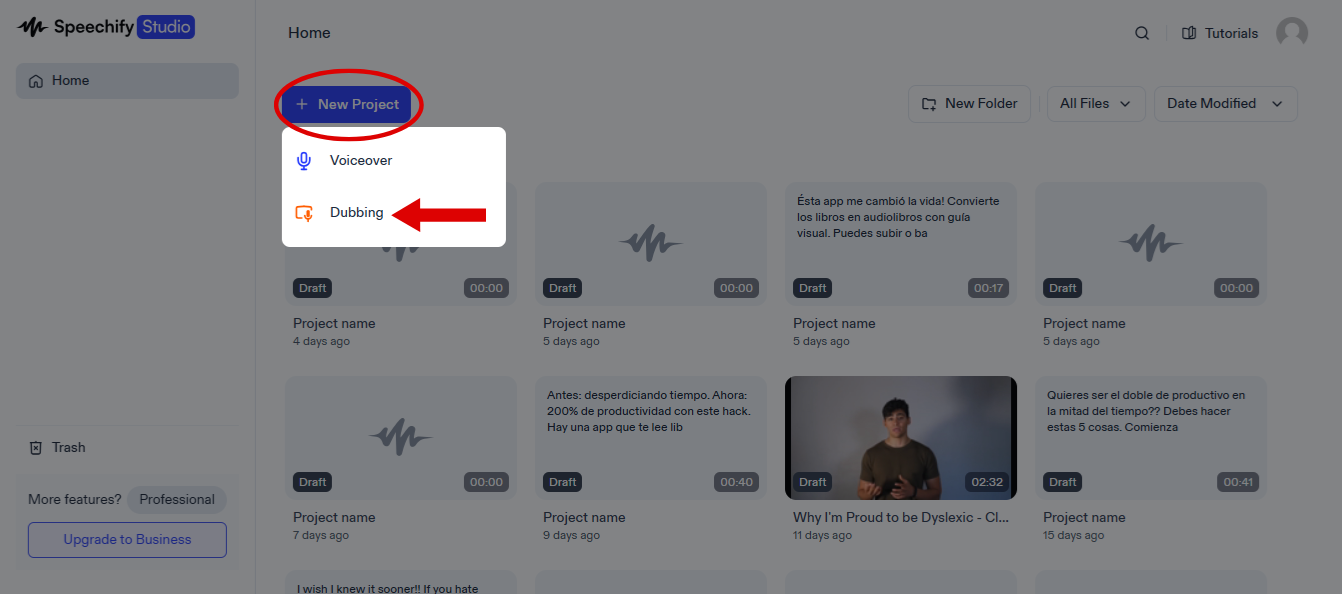
Upload your video: Start by uploading your video files to Speechify Studio, selecting the number of speakers in the video, choosing the language of your original video (e.g., English), and then decide whether you wish to remove filler words or extract the pauses from the original video. Lastly, hit “submit.”
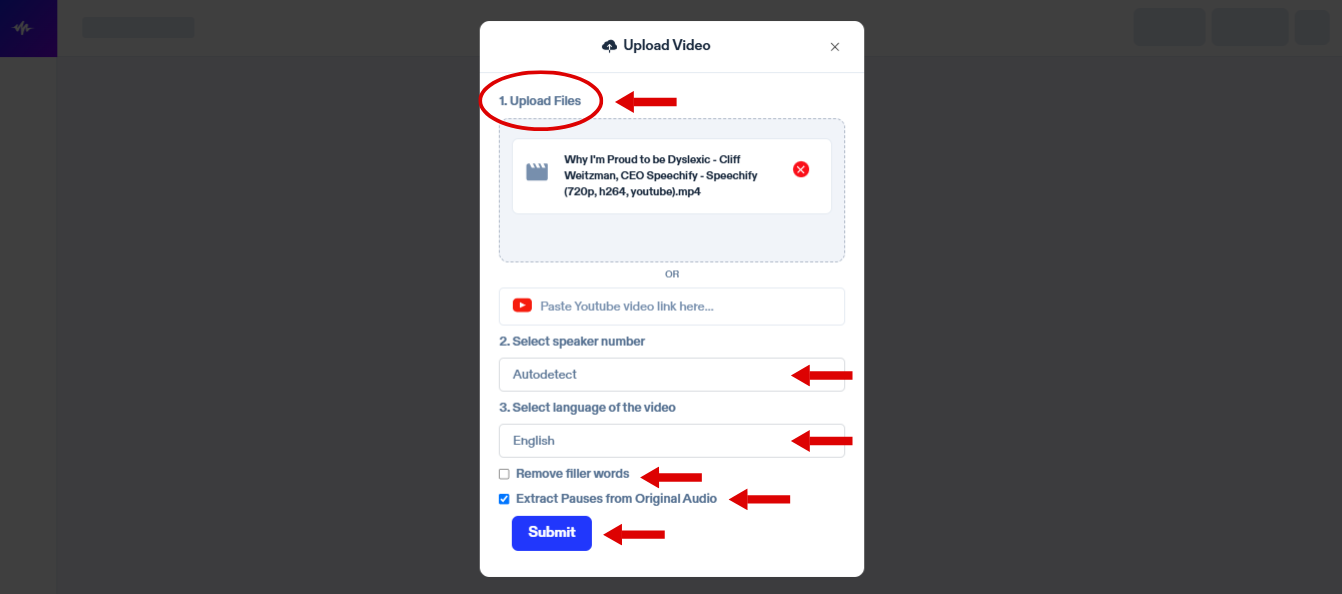
Transcribe the audio: Upon uploading your files, Speechify Studio automatically transcribes the original audio into text, which you can select to modify or edit.
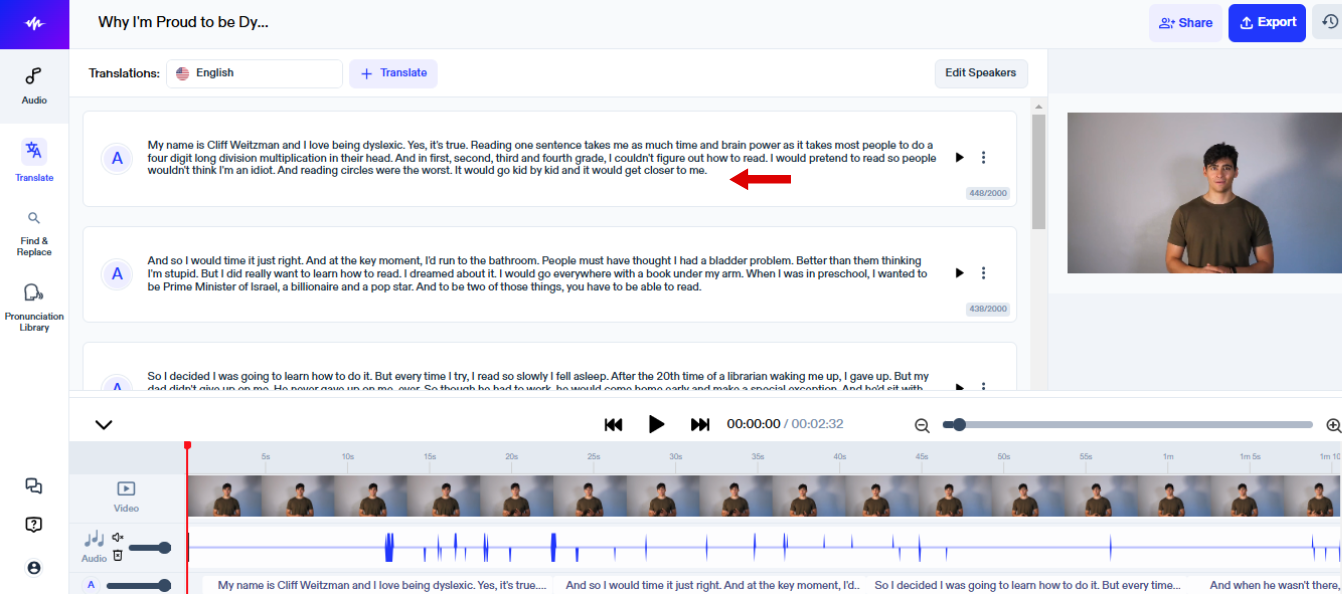
Select Spanish as the target language: Tap “translate.” In the “to” section, select your desired language for dubbing. In this case, select the proper Spanish dialect according to your needs.
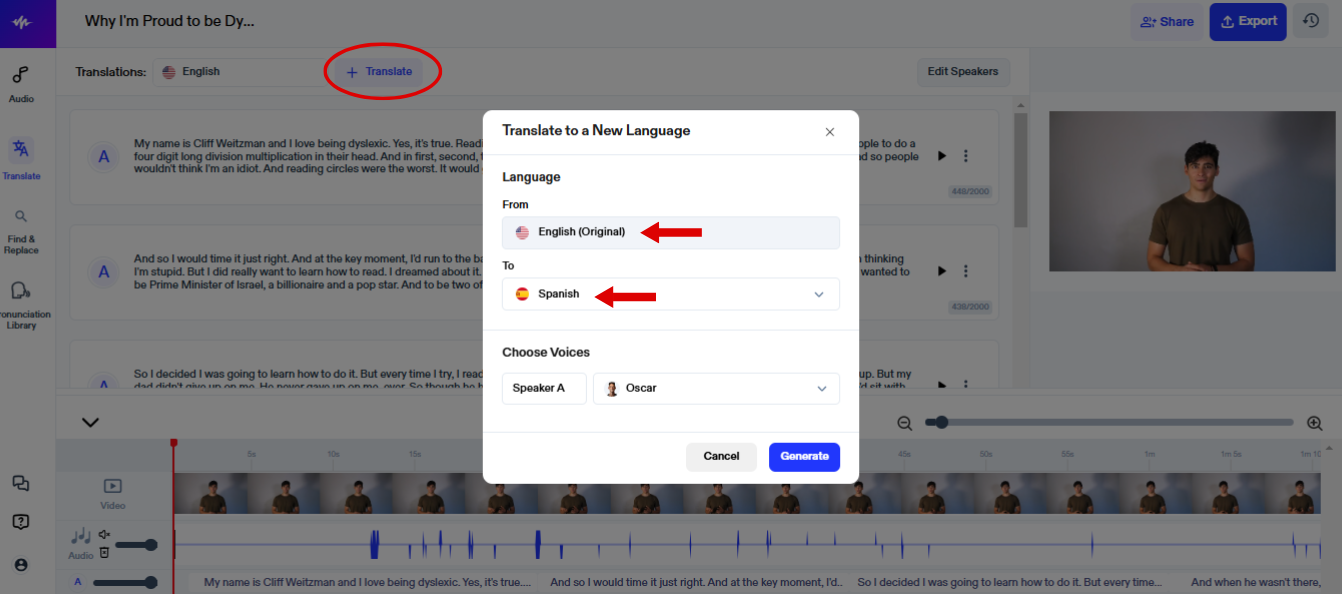
Pick a Spanish voice: Select a natural-sounding Spanish AI voice for each speaker in your video from the options.
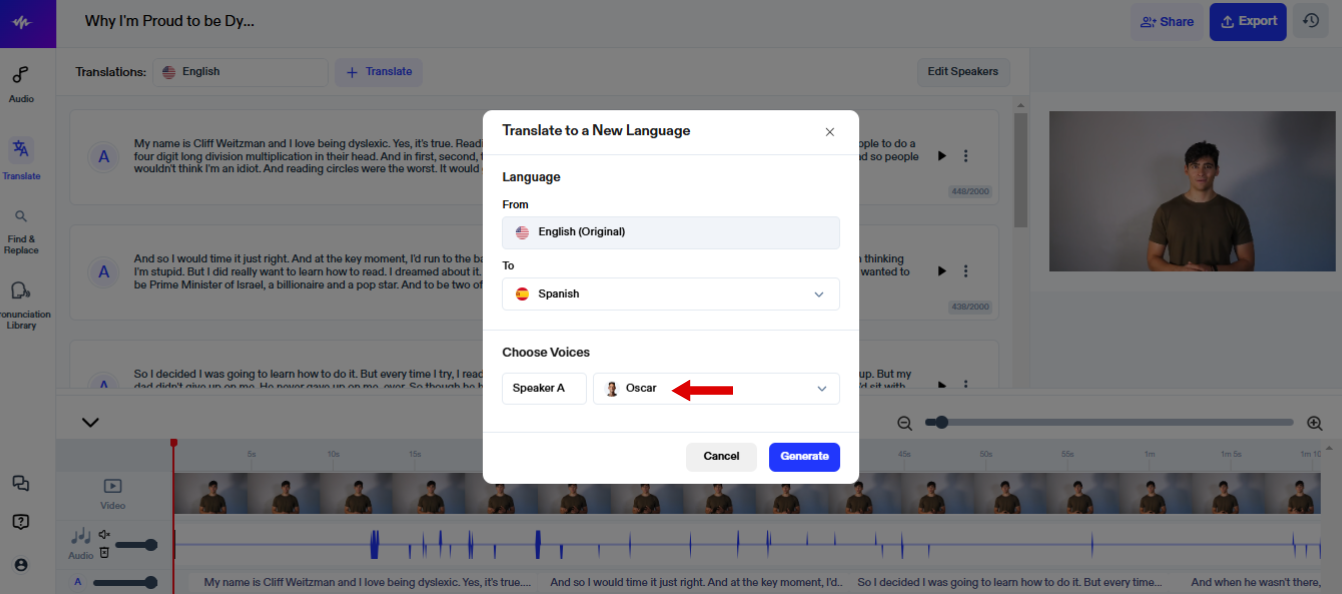
Dub your video: Choose “generate” and Speechify Studio will automatically translate and dub your video content into Spanish to ensure lip-synching matches lip movements.
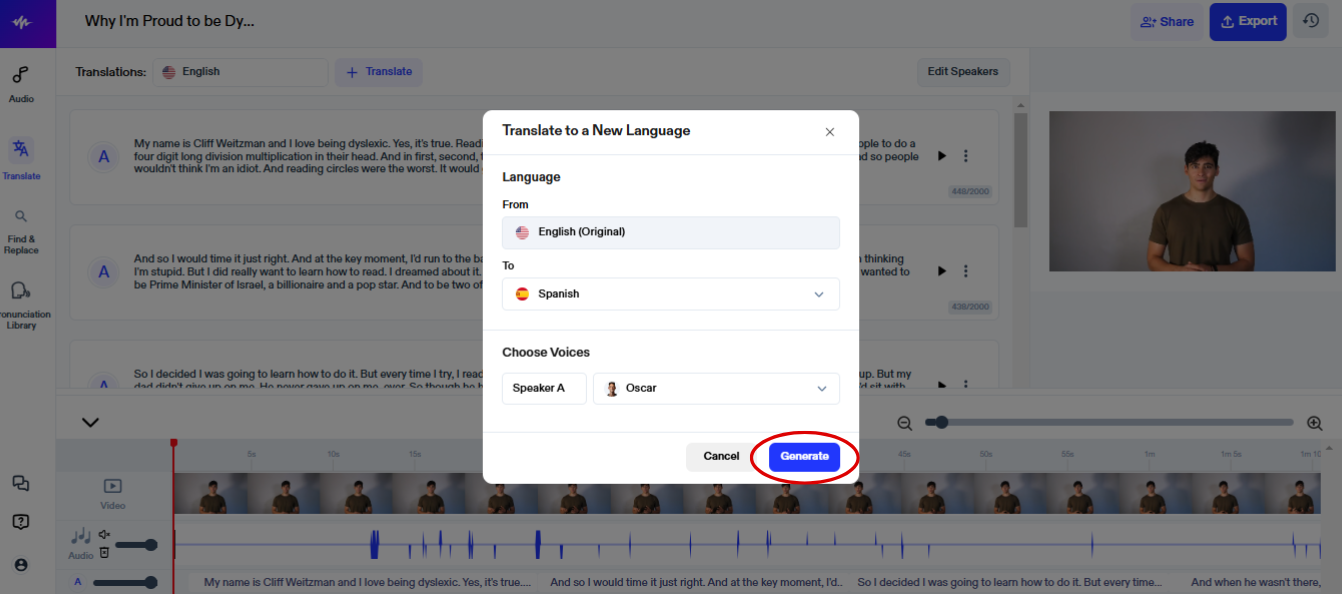
Download the final video: Once the dubbing is complete, download your video with the new Spanish voice over by selecting “export.”
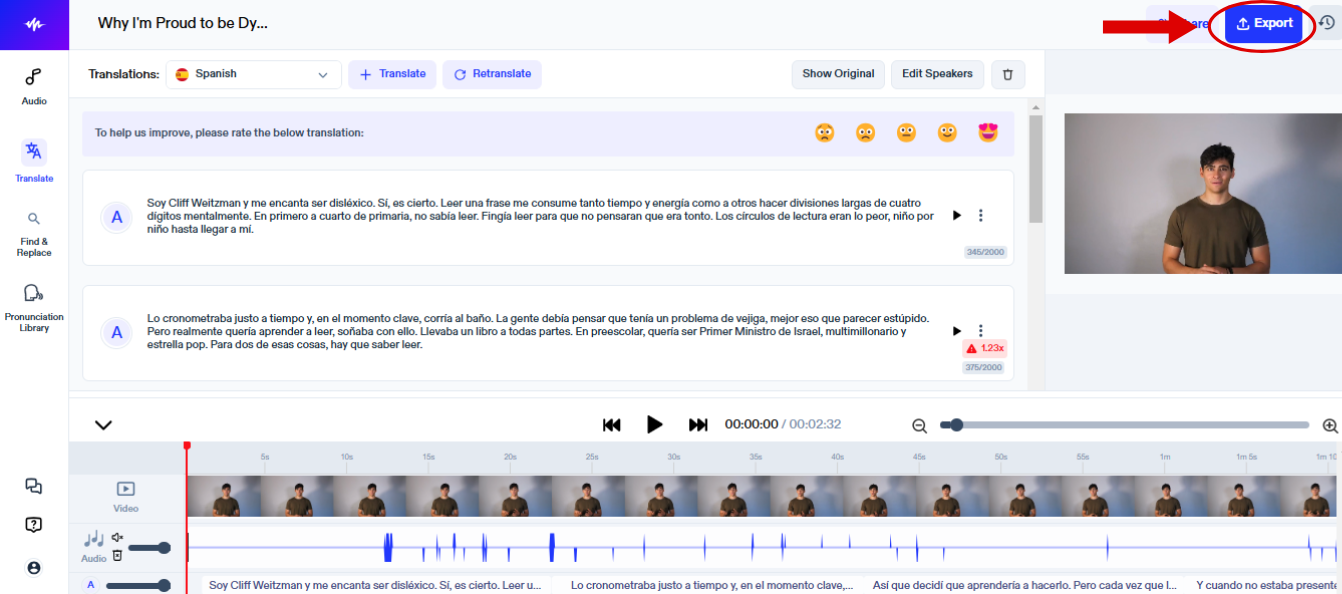
Speechify Studio’s Spanish AI Voice Generator
Speechify Studio’s Spanish AI voice generator is one of the best AI dubbing tools on the market. It focuses on linguistic and cultural factors to ensure high-quality, authentic voice output as well as features:
- Extensive library of lifelike AI voices: With over 150+ AI voices in various languages and accents, including but not limited to Spanish, Polish, Korean, Tamil, Russian, Chinese, Japanese, Italian, Arabic, German, Greek, French, Portuguese, Hindi, and more, Speechify Studio provides some of the most realistic and lifelike voices available on the market.
- Largest selection of Spanish languages and accents: Speechify Studio features over 150+ languages and accents, including Spanish dialects found in Argentina, Bolivia, Chile, Columbia, Costa Rica, Cuba, the Dominican Republic, Ecuador, El Salvador, Equatorial Guinea, Guatemala, Honduras, Nicaragua, Panama, Peru, Puerto Rico, Paraguay, Spain, the United States, Uruguay, Venezuela as well as European Spanish and Mexican Spanish.
- AI voice cloning: Speechify Studio not only offers users an advanced Spanish dubbing platform, but it also offers you access to Speechify Voice Over Studio which features Spanish AI voice cloning, enabling users to replicate their own voice and maintain their unique style in translated videos.
- Precise control: Speechify Studio allows for pronunciation adjustments. With the platform, users can easily edit Spanish dubs on a granular level line by line where necessary.
- Voice over adjustments: Through the Voice Over feature users can also adjust the pitch, emotion, and tone of the Spanish AI voices. These features are coming soon to the Dubbing interface as well.
- Pronunciation of unique sounds: Speechify Studio correctly pronounces key Spanish sounds like the rolled "R" in “perro” and the “ñ” in “niño” to maintain authenticity. It also knows the differences between dialects such as that the 'll' sound in Argentina is pronounced as 'sh' (e.g., 'calle' pronounced 'cashe'), which differs from the 'y' sound used in Spain (e.g., 'calle' pronounced 'caye')."
- Context-aware translations: Speechify Studio recognizes formal vs. informal contexts and adjusts pronouns and speech patterns, such as using “usted” for formal settings and informal language for casual ones.
- Emotion synthesis: Speechify Studio can detect emotional tones in the original audio and adjust the dub accordingly, adding excitement, sadness, or sarcasm where needed.
- Lip syncing and synchronization: Speechify Studio offers advanced lip-syncing to ensure voice matches mouth movements, while also handling longer Spanish phrases without losing sync.
- Gender-specific forms: Speechify Studio differentiates between masculine and feminine forms of Spanish words, adjusting adjectives, pronouns, and verbs to match the gender of the characters, such as “niño” (boy) and “niña” (girl).
- Multi-speaker support: Speechify Studio allows seamless dubbing for multiple speakers within the same video, distinguishing between different voices and adjusting language nuances accordingly, ensuring clear and accurate translations for multi-character dialogue.
- API solution: Speechify Studio provides a robust Spanish AI voice API for easy integration into other platforms, allowing businesses and developers to incorporate its powerful AI dubbing and voice generation capabilities into their workflows with minimal hassle.
Speechify Studio’s AI Voice Generator Understands Spanish
Not only is Speechify Studio able to dub and translate content into Spanish, but it truly understands the linguistic diversity of the language so that your Spanish AI voice overs and dubs are as natural as possible. Here’s a brief look at how Speechify Studio understands the differences and nuances across the various regions where Spanish is spoken to ensure the highest quality dubs:
Pronunciation
Speechify Studio knows that different regions have different pronunciations such as:
- Spain (Castilian Spanish): Castilian Spanish is known for the use of "ceceo" (the “th” sound for "c" and "z" before "i" or "e"), so words like zapato (shoe) are pronounced "thapato" in much of Spain, unlike in Latin America where it would be "sapato." In Spain, the pronoun vosotros (you all) is used for the informal plural “you,” whereas in Latin America, only ustedes is used for both formal and informal contexts.
- Mexico (Mexican Spanish): Mexican Spanish offers a clear, neutral accent. There is minimal use of the “seseo” (softened "s" sound), making it close to textbook Spanish in pronunciation.
- Central America (Guatemala, Honduras, El Salvador, Nicaragua, Costa Rica, Panama): Each Central American country has its own Spanish accent, but they share similarities, often having a softer tone and incorporating indigenous and colloquial influences. It knows that certain sounds may be softened or dropped at the ends of words, like in “está” (is), which might sound like "eh-tá."
- Caribbean (Cuba, Puerto Rico, Dominican Republic): Caribbean Spanish is fast-paced and features some of the most distinctive pronunciation patterns in the Spanish-speaking world. such as consonants at the ends of words, particularly "s" and "r." For instance, estar might sound like "etá" and pues like "pue”, which makes Caribbean Spanish sound more relaxed.
Vocabulary Differences
In addition to pronunciation differences, Speechify Studio has mastered the regional vocabulary differences across Spanish dialects, so it makes sure to use the proper word for the same object or concept depending on which dialect it’s dubbing in. This helps protect against cultural sensitivity since certain phrases or terms may hold different meanings in various regions due to cultural context. For example, coger means “to take” in Spain, but in Mexico, it has a strong slang connotation. Here are some more examples of vocabulary differences:
- Bus: Autobús (Spain, Mexico), guagua (Caribbean and Canary Islands), ómnibus or colectivo (Argentina).
- Computer: Ordenador (Spain), computadora (Latin America).
- Juice: Zumo (Spain), jugo (Latin America).
- Popcorn: Palomitas (Spain), pochoclo (Argentina), canchita (Peru), maíz pira (Colombia).
Grammatical Differences
Speechify Studio understands the differences in grammar between various Spanish dialects, including:
- Pronouns and verb conjugation: For instance, many South American countries, including Argentina, Uruguay, and parts of Central America, use voseo, where vos replaces tú for “you” in informal situations. This also changes verb conjugations; for example, “you eat” is vos comés in Argentina instead of tú comes.
- Verb tenses: In Spain, the present perfect tense is often used to describe recent events (e.g., he comido for “I have eaten”). In Latin America, the preterite is used more frequently in such cases (e.g., comí for “I ate”). The AI should adjust these tense preferences based on the target audience.
- Diminutives: Diminutives like -ito and -ita are widely used in Spanish, but some regions have their own variations. In Mexico, -ito is standard, while Costa Rica and Colombia may use -ico or -ica (e.g., momentico for “little moment”).
- Augmentatives: In Argentina, -azo is commonly used for emphasis (e.g., golazo for a great goal in soccer), while in Mexico, -ón is more common (e.g., comilón for “big eater”). The AI should adapt these suffixes to align with regional usage.
Benefits of Spanish Dubbing
With over 500 million native Spanish speakers worldwide, dubbing your content in Spanish opens up opportunities to reach a vast audience, especially in regions like Latin America and the U.S. Hispanic market. Some of the benefits of using Spanish AI voices include:
- Accurate localization: Spanish is spoken across many countries, each with its own accents and dialects. AI dubbing tools allow you to adapt the voice over to specific regions, such as the softer "z" sound of Castilian Spanish in Spain versus the "s" sound common in Latin American Spanish.
- Cost-effectiveness: Traditional dubbing can be expensive, especially when localizing into multiple languages. AI dubbing provides an affordable alternative, making it accessible to content creators and businesses on a budget.
- Scalability: AI-powered dubbing tools can handle anything from single videos to entire content libraries. You can easily dub hundreds of videos into Spanish or other languages like French, German, and Portuguese, saving time and reducing costs.
AI Dubbing: Text to Speech Spanish AI Voices vs. Voice Cloning
If using Spanish AI voices seems like a good fit for your project, there’s good news - you can choose between Spanish text to speech AI voices or voice cloning. Both are powerful methods that offer lifelike Spanish AI voice overs.
Spanish Text to Speech Voices
If you use text to speech dubbing, Spanish AI voices can be used to read a script, converting text into lifelike speech. These are pre-designed Spanish text to speech AI voices, each optimized for clarity and realism and designed to be easily understood by a wide audience. They are perfect for business or tutorial videos, multilingual social media campaigns, and marketing ads. These Spanish text to speech AI voices have improved significantly over the years and can now mimic human emotion and tone, making them sound just as natural as voice actors. Spanish TTS voices also come with different accents, so whether you're targeting Mexican, European, or Argentine audiences, there's a TTS voice to fit your needs.
Spanish Voice Cloning
Voice cloning technology, on the other hand, allows AI to replicate a specific person’s voice, which can then be used to dub content in different languages, such as in this case, Spanish. The result is a seamless, natural-sounding dub that closely matches the speaker’s tone, inflection, and personality. Voice cloning is particularly useful for content creators who want to maintain their personal brand across different languages, allowing their original voice to remain intact even when speaking in a foreign language, such as podcasters, YouTubers, or other well-known creators.
Speechify Studio Use Cases for Spanish AI Dubbing
Dubbing with Spanish AI voices has a wide range of applications that allow creators, businesses, and media companies to reach Spanish-speaking audiences more effectively. Below are several key use cases and scenarios where dubbing in Spanish using AI voices on Speechify Studio can be particularly beneficial:
Spanish AI Voices for Podcasts
Dubbing podcasts into Spanish helps creators reach large audiences in Spain, Latin America, and the U.S. For example, The Daily from The New York Times is available in Spanish. Speechify Studio allows podcasters to dub episodes without hiring voice actors.
Spanish AI Voices for Social Media
Creators on TikTok and YouTube, like MrBeast, use dubbing to expand their reach to Spanish-speaking audiences. Speechify Studio helps YouTubers dub content into Spanish, maximizing engagement.
Spanish AI Voices for Multilingual Marketing Campaigns
Brands like Coca-Cola and Telefónica dub campaigns into Spanish to connect with Spanish-speaking markets worldwide. Speechify Studio can assist companies in localizing ads and marketing materials to reach a wider audience.
Spanish AI Voices for Audiobooks
Spanish-language audiobooks are on the rise and platforms like Audible offer bestsellers such as El Alquimista, a translation of The Alchemist by Paulo Coelho. AI dubbing with Speechify Studio enables faster production of Spanish audiobooks.
Spanish AI Voices for Entertainment
Television shows and streaming platforms often rely on dubbing to ensure their content reaches global audiences. For example, Netflix dubs shows in Spanish like Stranger Things and The Witcher in both Latin American and Castilian. With Speechify Studio, production teams can streamline the Spanish dubbing process for global markets.
Spanish AI Voices for Educational Content
Spanish educational platforms and online eLearning courses have increasingly adopted AI dubbing to create multilingual versions of their content. Companies like Coursera and edX offer courses in multiple languages, and Speechify Studio’s AI dubbing allows these platforms to easily convert their content into Spanish.
Spanish AI Voices for Video Games
Popular titles like The Last of Us and Assassin’s Creed have been dubbed into multiple languages, including Spanish, allowing players to fully immerse themselves in the game’s narrative. By using Speechify Studio, game developers can dub video game dialogue in Spanish in real time, reducing production time and costs.
Spanish AI Voices for Accessibility
AI dubbing enhances accessibility for Spanish-speaking audiences, particularly for the visually impaired. Organizations like ONCE (Organización Nacional de Ciegos Españoles), which advocates for visually impaired individuals in Spain, could use AI dubbing to enhance accessibility of its video content.
Speechify Studio Competitors with Spanish AI Voices
Although Speechify Studio ranks among the top AI dubbing platforms, it's not the only Spanish AI voice generator available. Let’s take a look at how it compares to some of its competitors that also provide Spanish AI voice options:
Speechify Studio
- 150+ languages & accents, including 50+ Spanish AI voices
- Easy-to-use all-in-one video editing platform
- Preserves emotion, timing, tone, and unique characteristics of the original speaker
- Multi-speaker support
- Auto-subtitling
- Stock music and video footage
- Voice cloning and lifelike text to speech Spanish AI voices
ElevenLabs
- 29 languages
- Editing interface
- Preserves emotion, timing, tone, and unique characteristics of the original speaker
- Multi-speaker support
- Voice cloning and text to speech AI voices
Rask
- 135 languages
- Voice cloning and text to speech AI voices
- Made for films
- Multi-speaker support
- Lip sync
Murf
- 20+ languages
- Maintains the same vibe, tone, and emotion of original speakers
- Voice cloning and text to speech AI voices
DupDub
- 70+ languages & accents
- Auto subtitles
- Multi-speaker support
- Maintains original speaker style and presentation
- Lip sync
- Voice cloning and text to speech AI voices
Dubverse
- 60+ languages
- Auto subtitling
- Contextual translations
- Lip sync
- Multi-pronunciation and tone capabilities depending on the speaker
- Voice cloning and text to speech AI voices
Wavel
- 70+ languages
- Maintains tone, speech style, and timing of original speaker
- 95% accuracy
- Multi-speaker support
- Synchronization
- Voice cloning and text to speech AI voices
InVideo
- 50+ languages & accents
- Multiplayer editing for teams
- 16+ million stock media
- Voice cloning and text to speech AI voices
Conclusion
AI-powered dubbing tools have changed the way content creators can dub videos into multiple languages, including Spanish, French, Japanese, and beyond. With platforms like Speechify Studio offering high-quality, natural-sounding AI voices, it’s easier than ever to reach a global audience and break language barriers. Whether you're creating podcasts, YouTube videos, or marketing ads, AI dubbing can help you localize your content quickly, efficiently, and affordably.
FAQ
How can I dub a video online using AI?
To dub a video online using AI, you can upload the video to platforms like Speechify Studio, choose the target language, and apply AI-generated voices for the dubbing process.
What is localization?
Localization involves adapting content to fit the cultural and linguistic nuances of a specific region, and platforms like Speechify Studio help achieve this by offering AI dubbing in various languages.
How easy is Spanish video dubbing online?
Spanish video dubbing is made incredibly easy with AI tools like Speechify Studio, which provides quick voice generation and seamless integration into videos.
Can AI translate a video?
Yes, AI platforms like Speechify Studio allow you to translate and dub videos with natural-sounding AI voices.
How can I dub a video with AI voice?
To dub a video with AI voice, upload the video, select the preferred AI voice, and sync the voice over with the video using tools like Speechify Studio’s AI voice over generator.
What is AI video dubbing?
AI video dubbing refers to the use of artificial intelligence to generate voice overs either through text to speech or voice cloning in different languages for videos, a process made simple and efficient by platforms like Speechify Studio.
Can I add a Spanish voice over for free?
Some platforms, including Speechify Studio’s Spanish AI voice over generator, offer free pricing tiers or trials that allow you to add Spanish voice overs, although premium features may require a subscription.





